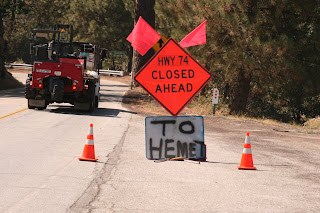On Friday night, the Forest Service organized and conducted a meeting to discuss the Cottonwood Fire. The meeting started at 6 p.m. at Idyllwild School. Both Marshall Smith and myself attended. Below is his rendition of the session. In the blog below this one is my version.
Friday at 11:45 p.m.Between 300 and 400 people turned out to hear representatives of the U.S. Forest Service, CalFire, Riverside County Office of Emergency Services (OES), the Sheriff’s Department and Idyllwild Fire Protection District discuss current fire strategies and contingency plans.
Salient points included that although the fire has expanded to 2,200 acres, winds are blowing downslope and in a westerly direction, at a moderate rate of 10 mph, expected to increase to 12 mph tonight (Idyllwild is northeast of the present fire location); the fire is low-burning, moving through dry brush with the greatest expansion of the fire on its westerly edge; weather conditions are not expected to change dramatically over the next couple of days. If anything, temperatures will cool slightly in the next three to four days; fire containment is at 10 percent, up from 5 percent earlier this afternoon; and initial Forest Service firefighters, before being joined by CalFire, were able last night to keep the fire from crossing a critical point at the North Fork of the San Jacinto. Incident commander Mike Wakoski said, “The fire has not really moved much today. Things are looking real good on this fire.”
Riverside County Sheriff Lt. Henry Sawicki reassured attendees that the department, which is responsible for evacuation and notifying residents when to evacuate and the route to take, have 50 deputies standing by and more at the ready should the need arise. Contingency plans, once the fire passes an evacuation “trigger point” set at Fisherman’s Point, should allow deputies six to eight hours to deploy to the Hill, set up evacuation routes and begin evacuating residents.
If the fire behaves in the future as it has today, Sawicki and fire officials do not believe evacuation will be necessary. Of course, all were cautious to state that changes in weather, wind and fire behavior could change all that.
OES Deputy Director Peter Lent, in response to a question from an audience member, said all evacuees are asked to check in at designated shelters, even though they may move on to private homes of friends or relatives or other private accommodations. In response to another question, Lent explained that the county Early Warning Notification System (EWNS) will, at the time the Fisherman’s Point trigger point is crossed, begin sending out calls to all Hill land lines and registered cell phones that evacuation is being ordered. Cell phones, unless already registered, will not be able to be registered in time for this incident. It takes 30 days, once they are entered online, for registration to be in the system.
CalFire/Riverside County Unit Chief John Hawkins, in a rousing affirmation of official determination and organization, said, “Collaboration among all official agencies ensures that anytime any major emergency happens, there will be a unified command, and there will be no Katrina-like screw up of that command.”
Ron Roberts, staff for Riverside County 3rd District Supervisor Jeff Stone, gave a message from the supervisor. “Please tell the people of the mountain we are committed to their public safety and that we will get you out early and safely [if that becomes necessary].”
Forest Service’s Greg Castleberry reminded attendees of the huge amount of clearance that has been done on Idyllwild’s western flank during the last four years. “If that fire goes through those areas that have been cleared, we will now have more options [because of those mosaic-patterned clearances].”
IFPD Chief Steve Kunkle explained “pre-trigger” points he had put in place that should the fire cross them, he would cancel the jazz festival. At this point, neither Kunkle nor other fire officials see that eventuality, but should it happen, the “pre-trigger” point affords officials adequate time to plan how to deal with the glut of festival patrons.
In answer to an audience question, Incident Command Team Public Information Officer Marc Peebles said even though there are many other Southern California fires, resources are prioritized based upon threats to community, power lines and grids, and water sheds. “There is a constant and fluid movement of resources based on exigent priorities.” His point was that adequate resources would be available to fight the Cottonwood Fire.



























